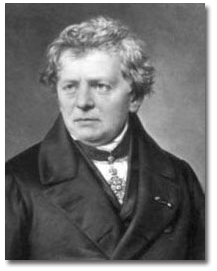Ampere and Ohm
 Andre Marie Ampere, a French mathematician who devoted himself to the study of electricity and magnetism, was the first to explain the electrodynamic theory. A permanent memorial to Ampere is the use of his name for the unit of electric current. Andre Marie Ampere, a French mathematician who devoted himself to the study of electricity and magnetism, was the first to explain the electrodynamic theory. A permanent memorial to Ampere is the use of his name for the unit of electric current.
George Simon Ohm, a German mathematician and physicist, was a college teacher in Cologne when in 1827 he published, "The galvanic Circuit Investigated Mathematically". His theories were coldly received by German scientists but his research was recognized in Britain and he was awarded the Copley Medal in 1841. His name has been given to the unit of electrical resistance, the ohm.
The possibility that electricity does not consist of a smooth, continuous fluid probably occurred to many scientists. Even Franklin once wrote that the "fluid" consists of "particles extremely subtile." Nevertheless, a great deal of evidence had to be accumulated before the view was accepted that electricity comes in tiny, discrete amounts, looking not at all like a fluid when viewed microscopically. James Clerk Maxwell opposed this particle theory. Toward the end of the 1800's, however, the work of Sir Joseph John THOMSON (1856-1940) and others proved the existence of the ELECTRON.
Thomson had measured the ratio of the electron's charge to its mass.
 Then in 1899 he inferred a value for the electronic charge itself by observing the behavior of a cloud of tiny charged water droplets in an electric field. This observation led to Millikan's famous Oil-Drop Experiment. Robert MILLIKAN, a physicist at the University of Chicago , with the assistance of his student Harvey Fletcher, sought to measure the charge of a single electron, an ambitious goal in 1906. A tiny droplet of oil with an excess of a few electrons was formed by forcing the liquid through a device similar to a perfume atomizer. The drop was then, in effect, suspended, with an electric field attracting it up and the force of gravity pulling it down. By determining the mass of the oil drop and the value of the electric field, the charge on the drop was calculated. The result: the electron charge -e- is negative and has the value e = 1.60/10,000,000,000,000,000,000 coulombs. Then in 1899 he inferred a value for the electronic charge itself by observing the behavior of a cloud of tiny charged water droplets in an electric field. This observation led to Millikan's famous Oil-Drop Experiment. Robert MILLIKAN, a physicist at the University of Chicago , with the assistance of his student Harvey Fletcher, sought to measure the charge of a single electron, an ambitious goal in 1906. A tiny droplet of oil with an excess of a few electrons was formed by forcing the liquid through a device similar to a perfume atomizer. The drop was then, in effect, suspended, with an electric field attracting it up and the force of gravity pulling it down. By determining the mass of the oil drop and the value of the electric field, the charge on the drop was calculated. The result: the electron charge -e- is negative and has the value e = 1.60/10,000,000,000,000,000,000 coulombs.
This charge is so small that a single copper penny contains more than 10,000,000,000,000,000,000,000 electrons.
Bulk matter is normally neutral. The tendency is for every positive proton in an atom to be electrically balanced against a negative electron, and the sum is as close to zero as anyone has been able to measure. In 1911, Ernest RUTHERFORD proposed the nuclear ATOM. He suggested that electrons orbit a positively charged nucleus less than 1/100,000,000,000,000 meters in diameter, just as planets orbit the Sun. Rutherford also suggested that the nucleus is composed of PROTONS, each having a charge +e. This view of matter, still considered correct in many ways, established the electrical force as that which holds an atom together. After Rutherford presented his atom, the Danish physicist Niels BOHR (see the book PHOTOBIOTICS) proposed that the electrons have only certain orbits about the nucleus, that other orbits are not possible.
The 19th century saw great strides in the advancement of electrical knowledge. Almost all the systems we use today for electrical production and transmission of power were developed by then - oil-filled capacitors (line transformers next to your house), 3-phase power (220 volt), high voltage tension lines, etc. had been invented by Tesla...
|